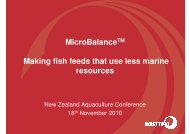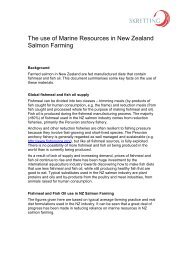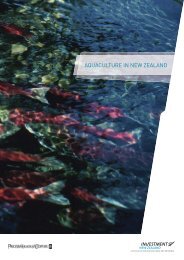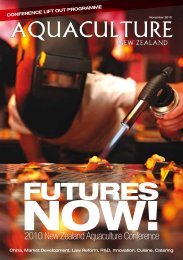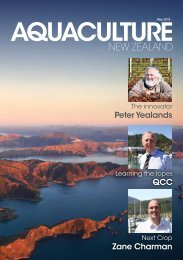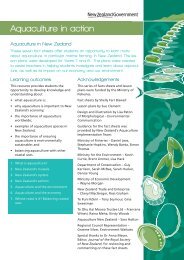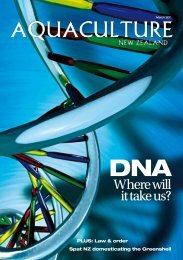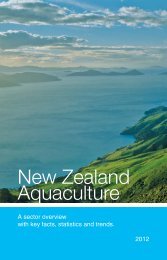Aquaculture New Zealand Commodity Levy Information Booklet
Aquaculture New Zealand Commodity Levy Information Booklet
Aquaculture New Zealand Commodity Levy Information Booklet
You also want an ePaper? Increase the reach of your titles
YUMPU automatically turns print PDFs into web optimized ePapers that Google loves.
2013 Proposed <strong>Commodity</strong> <strong>Levy</strong> on Mussels, Salmon and Oysters<strong>Information</strong> <strong>Booklet</strong>Please read this <strong>Information</strong> <strong>Booklet</strong> carefully before voting. You may vote in one of two ways:• e-vote: follow the instructions on your voting paper to make an on-line vote; OR• postal vote: complete and return your voting paper in the envelope supplied to the Returning Officer. The Returning Officer is:Warwick LamppElectionz.com LtdPO Box 3138, Christchurch 8140Whichever voting method you use, your vote must be received by the Returning Officer before the close of voting at 12 noon on Thursday28 February 2013.<strong>New</strong> <strong>Zealand</strong> <strong>Aquaculture</strong> Limited (trading as <strong>Aquaculture</strong> <strong>New</strong> <strong>Zealand</strong>, AQNZ) is the sector representative body incorporating Mussels, Oystersand Salmon in <strong>New</strong> <strong>Zealand</strong>. It was incorporated on the 26th of January 2007 with a purpose built constitution and sector strategy. Thisstrategy details the ten point plan to advance the industry’s goal of achieving a $1 billion dollar industry by the year 2025.The current order allows levies to be paid to <strong>New</strong> <strong>Zealand</strong> <strong>Aquaculture</strong> Limited (AQNZ) on all farmed: (“Mussels”); (“Oysters”); and (“Salmon”).”The Current Order came into force on 30 July 2007 and is due to expire on 29 July 2013. The Act requires that on the sixth anniversary of theday in which an order was made, if it has not previously been revoked, the order will cease to have effect.This is a referendum to determine the support to have a new compulsory levy order on all:(a) Greenshell TM mussels (of the species Perna canaliculus) (“Mussels”) 1 ;(b) Pacific oysters (of the species Crassostrea gigas) (“Oysters”) 2 ; and(c) Salmon (of the species Oncorhynchus tshawytscha) (“Salmon”) 3to fund the activities of <strong>Aquaculture</strong> <strong>New</strong> <strong>Zealand</strong>. The referendum is being conducted under the <strong>Commodity</strong> Levies Act 1990 (the Act).The Act requires that potential levy payers are made aware of certain aspects of the proposed levy arrangement and this information isprovided in accordance with the Act.This information booklet is in three parts:Part A) Description of <strong>Levy</strong> Proposal which contains a description of the levy proposal.Part B) Voting information contains instructions for votersPart C) Further information on setting levy rates describes the consultation that will need to occur before AQNZ sets oradjusts levy rates.1Means Greenshell TM mussel, a shellfish of the species Perna canaliculus (green-lipped mussel); but excludes mussel spat (mussels less than 40 mmlong)2Means the mollusc Crassostrea gigas (Pacific oyster); but excludes oyster spat (oysters less than 37 mm long)3Means fish of the species Oncorhynchus tshawytscha (Chinook or Quinnat salmon); but does not include salmon fingerlings that are harvested,whether or not onsold, for the purpose of transferring them in their live state to another fish farm or location.A) DESCRIPTION OF LEVY PROPOSALThis referendum is being conducted under the Act and thefollowing matters are specified in accordance with the Act.1. Why is AQNZ holding a referendum?This referendum is to ascertain the level of support for a newcommodity levy from farmers of Mussels, farmers of Salmon,and farmers of Oysters to fund the activities of AQNZ.The <strong>Commodity</strong> Levies (Mussel, Oyster, and Salmon) Order2007 (“Current Order”), made under the <strong>Commodity</strong> LeviesAct 1990 (“Act”), allows levies to be paid to <strong>New</strong> <strong>Zealand</strong><strong>Aquaculture</strong> Limited (“AQNZ”) on all:a. Mussels (Perna canaliculus).b. Oysters (Crassostrea gigas).c. Salmon (Oncorhynchus tshawytscha).This commodity levy, which is currently paid by farmers ofMussels, farmers of Salmon, and farmers of Oysters, fundsthe activities of AQNZ.The Current Order came into force on 30 July 2007 and is dueto expire on 29 July 2013. The Act requires that on the sixthanniversary of the day in which an order was made, if it hasnot previously been revoked, the order will cease to haveeffect.AQNZ would like to make an application to the Minister for anew levy order to come into force prior to 30 July 2013 (“<strong>New</strong>Order”). The Act requires AQNZ to gain over 50% support ina support referendum of all levy payers who have returnedtheir voting papers before the Minister can recommend themaking of the <strong>New</strong> Order.2. Who is the levy paid to and who is entitled to spend it?The levy is payable to AQNZ and AQNZ will impose, collectand be accountable for the expenditure of the levy.3. Is it compulsory?The levy is not voluntary – it will be compulsory for allpersons liable to pay the levy.4. What commodity is subject to the levy?The commodity subject to the levy will be:a. Greenshell TM mussels (of the species Perna canaliculus)
(“Mussels”) (means Greenshell TM mussel, a shellfish ofthe species Perna canaliculus (green-lipped mussel); butexcludes mussel spat (mussels less than 40 mm long)b. Pacific oysters (of the species Crassostrea gigas)(“Oysters”) (means the mollusc Crassostrea gigas (Pacificoyster); but excludes oyster spat (oysters less than 37 mmlong)c. Salmon (of the species Oncorhynchus tshawytscha)(“Salmon”) (means fish of the species Oncorhynchustshawytscha (Chinook or Quinnat salmon); but does notinclude salmon fingerlings that are harvested, whether ornot onsold, for the purpose of transferring them in theirlive state to another fish farm or location.)to fund the activities of <strong>Aquaculture</strong> <strong>New</strong> <strong>Zealand</strong>.The levy is imposed on Mussels, Oysters and Salmonharvested from Fish Farms and will cover the sale of allMussels, Oysters, and Salmon harvested from Fish Farms.The levy is payable to AQNZ.5. Who is primarily responsible for paying the levy?The person who is primarily responsible for paying the levyis the person who harvests and sells Mussels, Oysters andSalmon from aquaculture farming activities.By this mechanism, it is envisaged that all farmed Mussels,farmed Oysters, and farmed Salmon, will be caught by theprovisions of the levy.No person (in respect of the three species concerned) willbe exempt from paying the levy, although arrangements aremade for payments by conscientious objectors.6. On what basis is the levy imposed?The levy will be imposed on the basis of the greenweighttonnage of all Mussels, Oysters, and Salmon harvested forsale by Fish Farmers. 4 Greenweight is defined in the FisheriesAct as, in relation to any fish, aquatic life, or seaweed, theweight of fish, aquatic life, or seaweed before any processingcommences and before any part is removed. Salmon isusually sold as gilled and gutted. A conversion factor willapply to reflect the sold state to greenweight (this is currently1.15 for Quinnat Salmon). 57. Can a different levy rate be set for different species?The levy rate is different for different species. The levy rateproposed for the first year is set out in paragraph 15.8. How is the levy invoiced and collected?The levy will be collected by the levy collectors. In most casesthe levy collectors will be the licensed fish receivers of theharvested Mussels, Oysters or Salmon who will recover thelevy from the Fish Farmers 4 and will forward the levy moniesto AQNZ.In those cases where the commodity is harvested by FishFarmers who otherwise sell the fish or shellfish, the FishFarmers will pay the levy direct to AQNZ.Goods and services tax will be added to all payments and abuyer created invoice will be generated by the levy collectorand AQNZ.It is proposed that no levy collectors will be entitled to chargea collection fee as is the case with the current levy order.9. What happens if someone doesn’t pay the levy on time?The new levy order will be compulsory and is due forpayment on the date of the harvest of the commodity, withthe latest day of payment being the 20th day of the monthfollowing the month in which the commodity was harvested.The levy order will allow AQNZ to charge late levy payers anadditional levy of 10% of the unpaid amount.10. What is the levy period?The levy is set annually for a 12 month period commencingon 1st September each year.11. When will the levy commence?The first levy year will be from the date of commencement ofthe new levy order to 31 August 2014.The duration of the <strong>New</strong> Order will be six years from the dateit is made, unless an extension is sought and granted by theMinister a year before the fifth anniversary of the date inwhich the <strong>New</strong> Order expires.12. Is there a maximum rate of levy?The maximum rate of levy will be a rate, in dollars pergreenweight tonne, equivalent to:a. 2% of the relative dollar value of mussels harvested (plusGST)b. 2% of the relative dollar value of oysters harvested (plusGST)c. 2% of the relative dollar value of salmon harvested (plusGST)The relative dollar value for the specific species is found bymultiplying the total greenweight tonnage for each speciesproduced by Fish Farmers by the port price for that species.AQNZ will determine the port price for mussels, oysters, andsalmon using the port price (excluding GST) paid or likely tobe paid for mussels, oysters and salmon in each 12-monthperiod of the 3 years before the levy year to which the levyrelates.13. How is the annual levy rate set?AQNZ will set the levy rate, in accordance with its rules, priorto the start of the levy year following consultation with levypayers and ratified at the Annual General Meeting. If a newlevy rate is not fixed for a later year, then the rate last fixedapplies.The levy is in two parts: a generic aquaculture component(first tier) and a species specific component (second tier), thesum of which is the total levy.The generic levy rate for each species is calculated by dividingthe total dollar amount for the species, by an estimate of theannual tonnage, as recommended by the AQNZ Board.For the species specific levies (second tier levy) the calculationis made by taking the total amount of proposed expenditurefor each species, divided by an estimate of annual tonnage, asrecommended by the AQNZ Board.The total levy for each species group is the sum of the genericand specific levies for each species group.The levy payable may vary year to year. AQNZ is a cost basedcentre for the purposes of accounting and AQNZ’s financialneeds may change from year to year depending upon thework programme.14. How is the levy rate notified?All Fish Farmers of the three species, all Licensed FishReceivers (where applicable) and all Licensed Fish Farms (asdefined in the Fisheries Act 1994) will be notified in writingof the annual levy rate within 14 days of the levy rate beingapproved by shareholders in the Annual General Meeting ofAQNZ together with the date from which the levy takes effect.This information will also be published in the <strong>New</strong> <strong>Zealand</strong>Gazette.15. What is the initial levy rate?AQNZ must fix the actual rate of levy for the levy year ending31 August by any lawful means.The proposed levy rates for the first year will be;4Fish Farmer has the meaning it is given in section 2(1) of the Fisheries Act 19965Fisheries (Conversion Factors) Notice 2011.
Mussels $ 11.99 per greenweight tonneSalmonOysters$ 16.33 per greenweight tonne$ 29.50 per greenweight tonneThe levy rates were recently changed to cover the costsof a service agreement entered into with Seafood <strong>New</strong><strong>Zealand</strong> effective as at the 1st of October 2012. At the sametime levies previously paid to SeaFIC were rated to zero foraquaculture farmers.16. What can the levy be used for?The levy will be spent on the development and managementof the aquaculture industry as determined by the annualbudget and business plan, including any or all of the followingpurposes relating to aquaculture or aquaculture Fish Farmers:a. promoting aquaculture industry activities and marketdevelopment plans;b. research, including biological, environmental and marketresearch;c. public relations and representation activities associatedwith the aquaculture industry;d. trade mark and patent search, applications andprotection;e. iwi consultation and promoting iwi participation inaquaculture;f. development and updating of code(s) of practice;g. protection of property rights, including submissions oncoastal plans, seabed claims and coastal tendering;h. administration of approved annual activities and legalresponsibilities of AQNZ and including the collection ofindustry levies and management;i. development and implementation of quality assuranceprogrammes including food safety, water quality andecological performance; andj. the protection and improvement of the health of mussels,oysters and salmon.AQNZ must spend or (pending expenditure) invest all levymoney paid to it. No amount of the levy may be used forcommercial or trading activities. AQNZ will consult levy payerson its budget and proposed expenditure for the followingyear prior to the Annual General Meeting.17. Are there any exemptions?The only person to be exempt from paying the levy is theCrown.18. What about conscientious objectors?Under the <strong>New</strong> Order, a person who objects on conscientiousor religious grounds to paying the levy in the mannerprovided in the levy order may pay the amount to the ChiefExecutive of the Ministry for Primary Industries, who will thenpay the levy amount to AQNZ.19. What records must be kept?The levy collectors are required to keep levy records onAQNZ’s approved forms. These records will include:i. the name of the Fish Farmers whose farm theMussels, Oysters or Salmon were collected from;ii. the farm number the product was collected from;iii. the greenweight tonnage of product harvested (if agreenweight conversion factor is not supplied therelevant conversion factor in the Fisheries (ConversionFactors) Notice 2011 will be used – (currently 1.15 forSalmon - gilled and gutted);iv. the amount of levy collected from the levy payer; andv. the date of collection.A copy of the records is to be sent to AQNZ together withthe levy payment by the 20th day of the month following theharvest to determine the amount of the levy payable.The records are to be kept by the levy collector for a period of7 years.AQNZ must, in every levy year, keep records of the followinginformation:a. the amount of levy paid to it in that year and, for eachpayment:i. the date on which it is received;ii. the name of the person who paid it;iii. how, if at all, levies paid to it in that year wereinvested;iv. how, and when, all levies spent by it were spent.AQNZ must retain the records for at least 7 years after theend of the levy year to which the records relate.20. How is confidentiality maintained?People or organisations who gather information as a result ofthe levy order cannot divulge those details unless required toby law. This does not affect or prevent:a. The use and disclosure of such information for statisticalor research purposes provided the information will notbe published in a form that can identify any individual orwill only be published with the consent of all identifiableindividuals;b. Using such information to assist in the invoicing andcollection of levies;c. The production of records and accounts under section17(1) of the Act (which relates to the rights of theMinister to have accounts audited);d. The production of statements under section 25 of the Act(which relates to annual reports and statements);e. Disclosing or using information necessary in the givingof evidence in any legal proceedings taken under or inrelation to the levy order under the Act;f. The disclosure of information to, and the use of any suchinformation by, the Returning Officer to determine thevoting entitlement and to count the votes of personsprimarily responsible for paying the levy.B. VOTING INFORMATION21. Who is entitled to vote?All potential levy payers (i.e farmers of Mussels, farmers ofSalmon, and farmers of Oysters) are entitled to vote in thisreferendum.22. What level of support is required to establish a levy order?The Act requires that the Minister, before recommending a<strong>New</strong> Order, be satisfied “that during the 12 months beforethe support referendum the total amount of the commodityproduced by supporters was more than half of the total amountof the commodity produced by all participants” (section 5(2)(ah)). The voting paper is attached for those entitled to vote.An application for a commodity levy order can only be made if:i. the “Yes” vote is more than 50% of the vote cast;ii. and the total greenweight of harvested product byproducers who vote “Yes” is more than 50% of thetotal greenweight of product harvested by all voters.23. What is the basis for voting?The basis for voting is the greenweight tonnage for mussels,oysters or salmon produced by you through fish farming andsold during the 12 months ending as close as possible to 30November 2012.
24. How do I vote?You may vote in one of two ways:• e-vote: follow the instructions on your voting paper tomake an on-line vote; OR• postal vote: complete and return your voting paper in theenvelope supplied to the Returning Officer. The detailsof the Returning Officer are provided at the front of thisbooklet.Whichever voting method you use, your vote must bereceived before 12 noon on Thursday 28 February 2013.Votes received after this time will not be counted.25. How will information in the voting papers be treated?The information contained in the voting papers will beused by the Returning Officer to ascertain the level ofsupport for the new levy order. The voting papers will bedestroyed by the Returning Officer immediately upon thelevy order being confirmed by Order in Council, or upon thisreferendum failing to obtain the required level of support.The information in the voting paper will be provided to AQNZfor statistical and research purposes in a form that does notidentify any individuals.26. How will the results be notified?Everyone who receives a ballot paper will be notified of theresults in writing by AQNZ as soon as practicable after theresults are known to AQNZ.27. What if I need more information?Further information is available from AQNZ at the contactaddress below.28. What can I do if I object to the proposed levy?In addition to voting against the levy, any potential levy payeror person potentially affected by the levy can make theirobjection known to AQNZ and/or the Minister for PrimaryIndustries. You can write to:<strong>Aquaculture</strong> <strong>New</strong> <strong>Zealand</strong>Level 1, Wakatu House,Montgomery SquareNelson 7010Attention Gary HooperorMinister for Primary IndustriesParliament BuildingsWellingtonC. FURTHER INFORMATION ON SETTING LEVY RATESThis section is not part of the Ballot Paper. It explains theconsultation and approval process that AQNZ will be required byits Constitution to follow before it can set the annual levy ratesunder the <strong>New</strong> Order.OverviewThe consultation and approval process that must be followedbefore any levy rates can be set is explained in more detail below.These requirements are detailed in the AQNZ constitution.1. What are the components that make up the levy?The generic levy payment (first tier) will enable AQNZ to fundits core activities. The species specific levies (second tier levy)will be called upon to fund species specific work. The currentlevy rates set for the 2012 – 2013 year do not have a speciesspecific component.2. Who is accountable for the levy?The total levy (first and second tier) is paid to AQNZ andAQNZ is accountable for its expenditure. However, AQNZ willonly impose a second tier levy at the request of the specificspecies.3. Can the levy be set at variable rates?Variable rates can be set for the different species.4. How is the annual levy rate set?The levy is in two parts: a generic aquaculture component(first tier) and a species specific component (second tier), thesum of which is the total levy. Each year AQNZ managementwill present the AQNZ Board with a draft business planwhich sets out activities for the next financial year. This willbe accompanied by an estimated budget. The activities willbe divided into generic aquaculture activities and, whererelevant, species specific activities.After consultation with shareholders, the AQNZ Board will,if necessary, amend and approve the budget. The budgetwill then be voted on by shareholders in the Annual GeneralMeeting.The generic levy rate for each species is calculated by dividingthe total dollar amount for the species, by an estimate of theannual tonnage, as recommended by the Board.For the species specific levies (second tier levy) the calculationis made by taking the total amount of proposed expenditurefor each species, divided by an estimate of annual tonnage, asrecommended by the AQNZ Board to get the rate.The total levy for each species group is the sum of the genericand specific levies for each species group.The levy payable may vary year to year. AQNZ is a cost basedcentre for the purposes of accounting and AQNZ’s financialneeds may change from year to year depending upon thework programme.In any levy year, the levy must be calculated on the basisof the relative tonnage of the fish harvested and soldindividually for each species.Salmon is usually sold as gilled and gutted. A conversionfactor will apply to reflect the sold state to greenweighttonnage - this is currently 1.15 for gilled and gutted QuinnatSalmon.5. How will the levy rate be set for the first year?The levy rates for the 2012/13 levy year have been set asdetailed in paragraph 15. Consultation on the 2013/14 levyrate will occur and approval sought at the AGM to be held inJuly 2013.6. What consultation must AQNZ undertake before setting thecore levy rate for a year?Each year AQNZ management present the AQNZ Board witha draft business plan which sets out activities for the nextfinancial year. This will be accompanied by an estimatedbudget. The activities will be divided into generic aquacultureactivities and, where relevant, species specific activities.After consultation with shareholders, the AQNZ Board will,if necessary, amend and approve the budget. The budgetwill then be ratified by shareholders at the Annual GeneralMeeting. Once approved at the AGM the levy rate will be setfor the following year.7. How secure are these consultation provisions?Once the commodity <strong>Levy</strong> order is granted it cannot bealtered during the six year period of the order.8. What other checks and balances apply?AQNZ’s constitution requires auditors to audit theexpenditure of the levy money to ensure that money leviedfor core services and species specific work has been used forthe correct purposes.



